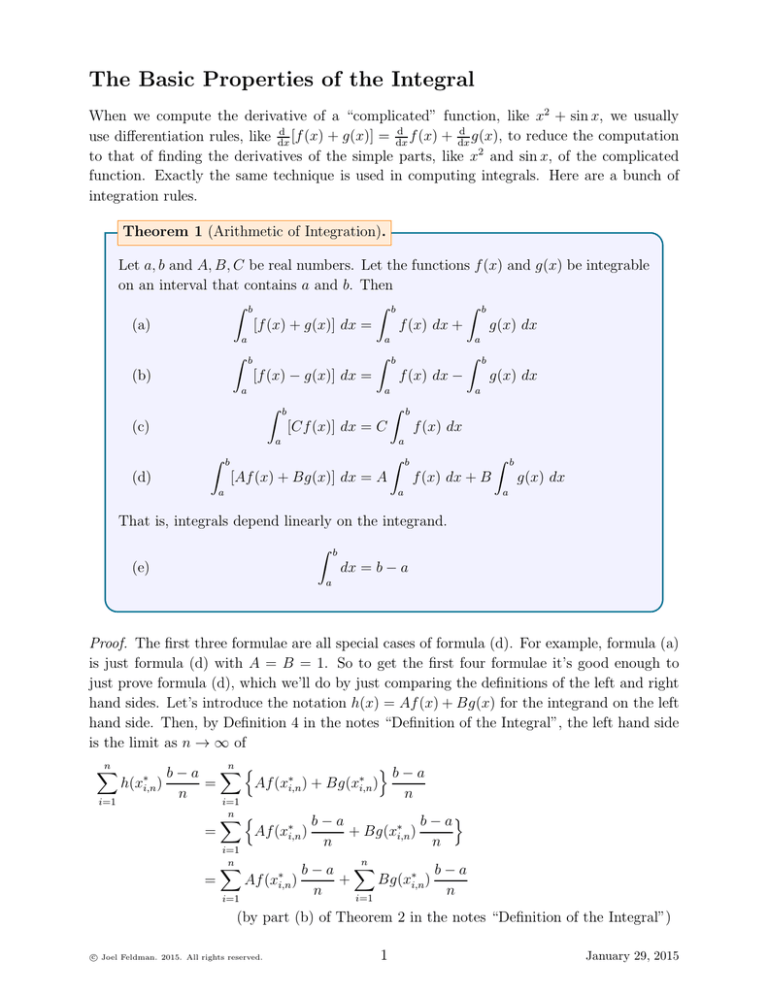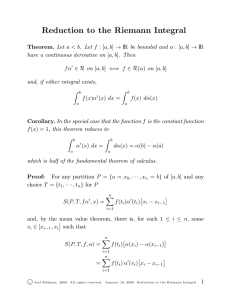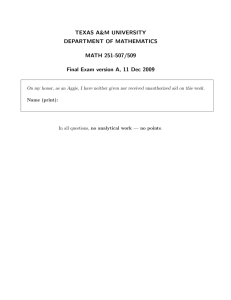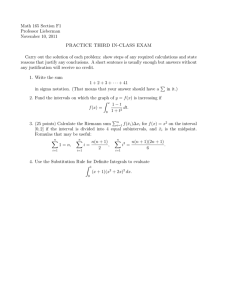The Basic Properties of the Integral
advertisement

The Basic Properties of the Integral When we compute the derivative of a “complicated” function, like x2 + sin x, we usually d d d [f (x) + g(x)] = dx f (x) + dx g(x), to reduce the computation use differentiation rules, like dx to that of finding the derivatives of the simple parts, like x2 and sin x, of the complicated function. Exactly the same technique is used in computing integrals. Here are a bunch of integration rules. Theorem 1 (Arithmetic of Integration). Let a, b and A, B, C be real numbers. Let the functions f (x) and g(x) be integrable on an interval that contains a and b. Then Z b Z b Z b (a) [f (x) + g(x)] dx = f (x) dx + g(x) dx a Z (b) a b [f (x) − g(x)] dx = a b [Cf (x)] dx = C a (d) Z a b f (x) dx − a Z (c) Z b [Af (x) + Bg(x)] dx = A a Z b g(x) dx a Z Z b f (x) dx a b f (x) dx + B a Z b g(x) dx a That is, integrals depend linearly on the integrand. Z (e) b dx = b − a a Proof. The first three formulae are all special cases of formula (d). For example, formula (a) is just formula (d) with A = B = 1. So to get the first four formulae it’s good enough to just prove formula (d), which we’ll do by just comparing the definitions of the left and right hand sides. Let’s introduce the notation h(x) = Af (x) + Bg(x) for the integrand on the left hand side. Then, by Definition 4 in the notes “Definition of the Integral”, the left hand side is the limit as n → ∞ of n X i=1 n h(x∗i,n ) ob−a b− a Xn = Af (x∗i,n ) + Bg(x∗i,n ) n n i=1 n Xn b−a b − ao = Af (x∗i,n ) + Bg(x∗i,n ) n n i=1 = n X n Af (x∗i,n ) i=1 b−a b−a X + Bg(x∗i,n ) n n i=1 (by part (b) of Theorem 2 in the notes “Definition of the Integral”) c Joel Feldman. 2015. All rights reserved. 1 January 29, 2015 =A n n X f (x∗i,n ) i=1 X b−a b−a +B g(x∗i,n ) n n i=1 (1) (by part (a) of Theorem 2 in the notes “Definition of the Integral”) Rb Rb Rb Rb Substituting the definitions of a f (x) dx and a g(x) dx into A a f (x) dx + B a g(x) dx gives that the right hand side is exactly the limit as n → ∞ of the last line of (1). Geometrically, formula (e) just says that the area of the rectangle with x running from a to b and y running from 0 to 1 is b − a, which is obvious. It is also easy to see formula (e) algebraically since, if we use f (x) = 1 to denote the integrand of the left hand side, then, by Defin ition 4 in the notes “Definition of the Integral”, Z b n n X X b−a b−a ∗ f (xi,n ) dx = lim = lim 1 = lim (b − a) = b − a n→∞ n→∞ n→∞ n n a i=1 i=1 Example 2 In Example 1 of the notes “Definition of the Integral”, we saw that Z 1 0 x Z e + 7 dx = 1 x e dx + 7 0 1 Z R1 0 ex dx = e − 1. So dx 0 (by Theorem 1.d with A = 1, f = ex , B = 7, g = 1) = (e − 1) + 7 × (1 − 0) (by Example 1 in the notes “Definition of the Integral” and Theorem 1.e) =e+6 Example 2 Theorem 3 (Arithmetic for the Domain of Integration). Let a, b, c be real numbers. Let the function f (x) be integrable on an interval that contains a, b and c. Then Z a (a) f (x) dx = 0 a (b) (c) Z a f (x) dx = − b Z Z b f (x) dx a b a c Joel Feldman. 2015. All rights reserved. f (x) dx = Z c f (x) dx + a Z b f (x) dx c 2 January 29, 2015 Proof. For notational simplicity, let’s assume that a ≤ c ≤ b and f (x) ≥ 0 for all a ≤ x ≤ b. Ra The identities a f (x) dx = 0, that is Area (x, y) a ≤ x ≤ a, 0 ≤ y ≤ f (x) = 0 Rb Rc Rb and a f (x) dx = a f (x) dx + c f (x) dx, that is, Area (x, y) a ≤ x ≤ b, 0 ≤ y ≤ f (x) = Area (x, y) a ≤ x ≤ c, 0 ≤ y ≤ f (x) + Area (x, y) c ≤ x ≤ a, 0 ≤ y ≤ f (x) are intuitively obvious. See the figures below. We won’t give a formal proof. y y y = f (x) a y = f (x) x a c b x Ra Rb So we concentrate on the formula b f (x) dx = − a f (x) dx. The midpoint Riemann Rb sum approximation to a f (x) dx with 4 subintervals is n 3 b − a 5 b − a 7 b − a o b − a 1 b − a +f a+ +f a+ +f a+ f a+ 2 4 2 4 2 4 2 4 4 n 7 o 1 3 5 7 5 3 1 b−a = f a+ b +f a+ b +f a+ b +f a+ b (2) 8 8 8 8 8 8 8 8 4 Ra We’re now going to write out the midpoint Riemann sum approximation to b f (x) dx with 4 subintervals. Note that b is now the lower limit on the integral and a is now the upper limit on the integral. This is likely to cause confusion when we write out the Riemann sum, so we’ll temporarily rename b to A and a to B. The midpoint Riemann sum approximation RB to A f (x) dx with 4 subintervals is n 3 B − A 5 B − A 7 B − A o B − A 1 B − A +f A+ +f A+ +f A+ f A+ 2 4 2 4 2 4 2 4 4 n 7 o 1 5 3 3 5 1 7 B−A = f A+ B +f A+ B +f A+ B +f A+ B 8 8 8 8 8 8 8 8 4 Now recalling that A = b and B = a, we have that the midpoint Riemann sum approximation Ra to b f (x) dx with 4 subintervals is 5 3 1 n 7 1 3 5 7 o a − b (3) f b+ a +f b+ a +f b+ a +f b+ a 8 8 8 8 8 8 8 8 4 The curly brackets in (2) and (3) are equal to each other — the terms are just in the reverse and a−b , are order. The factors multiplying the curly brackets in (2) and (3), namely b−a 4 4 negatives of each other, so (3)= −(2). The same computation with n subintervals shows that Ra Rb the midpoint Riemann sum approximations to b f (x) dx and a f (x) dx with n subintervals Ra Rb are negatives of each other. Taking the limit n → ∞ gives b f (x) dx = − a f (x) dx. c Joel Feldman. 2015. All rights reserved. 3 January 29, 2015 Example 4 We saw, in Example 8 of the notes “Definition of the Integral”, that, when B > 0, R0 R0 B2 B2 and . By Theorem 3, x dx = − x dx = 0 and 2 2 −B 0 −B Z x dx = − 0 Z 0 0 x dx = B2 2 x dx = −B We may combine the three statements Z B Z 0 B2 x dx = when B > 0 x dx = 0 2 0 0 RB Z −B x dx = 0 B2 when B > 0 2 into the single statement Z b x dx = 0 b2 for all real numbers b 2 (When b > 0, set B = b and when b < 0, set B = −b.) Applying Theorem 3 yet again, we have Z b Z 0 Z b x dx = x dx + x dx a a = 0 b Z x dx − 0 = b2 − a2 2 Z a x dx 0 Example 4 Example 5 Recall that ( |x| = if x ≥ 0 x −x if x ≤ 0 So Z 1 −1 f |x| dx = Z 0 f |x| dx + −1 0 = Z f (−x) dx + 1 Z 0 Z 1 f |x| dx f (x) dx 0 −1 Example 5 c Joel Feldman. 2015. All rights reserved. 4 January 29, 2015 Example 6 Here is a concrete example of how the method of Example 5 is used. We are going to compute R1 1 − |x| dx again. But this time we are going to use only the properties of Theorems 1 −1 and 3 and the facts that Z b Z b b2 − a2 (4) dx = b − a x dx = 2 a a Rb Rb 2 2 in Example 4. That a dx = b − a is part (e) of Theorem 1. We saw that a x dx = b −a 2 The purpose of this example is to show how the properties of Theorems 1 and 3 can be used R1 Rb Rb to rewrite −1 1 − |x| dx in terms of a dx and a x dx. First we are going to get rid of the absolute value signs. Recalling that |x| = x whenever x ≥ 0 and |x| = −x whenever x ≤ 0, we have, by Theorem 3.c, Z 1 Z 0 Z 1 1 − |x| dx = 1 − |x| dx + 1 − |x| dx −1 −1 0 Z 0 Z 1 = 1 − (−x) dx + 1 − x dx −1 0 Z 0 Z 1 = 1 + x dx + 1 − x dx 0 −1 Now we apply parts (a) and (b) of Theorem 1, and then (4). Z 1 Z 0 Z 0 Z 1 Z 1 − |x| dx = dx + x dx + dx − −1 −1 −1 = [0 − (−1)] + 0 1 x dx 0 12 − 02 02 − (−1)2 + [1 − 0] − 2 2 =1 Example 6 c Joel Feldman. 2015. All rights reserved. 5 January 29, 2015




